Science & Environment
Where will the UK bury nuclear waste for 100,000 years?
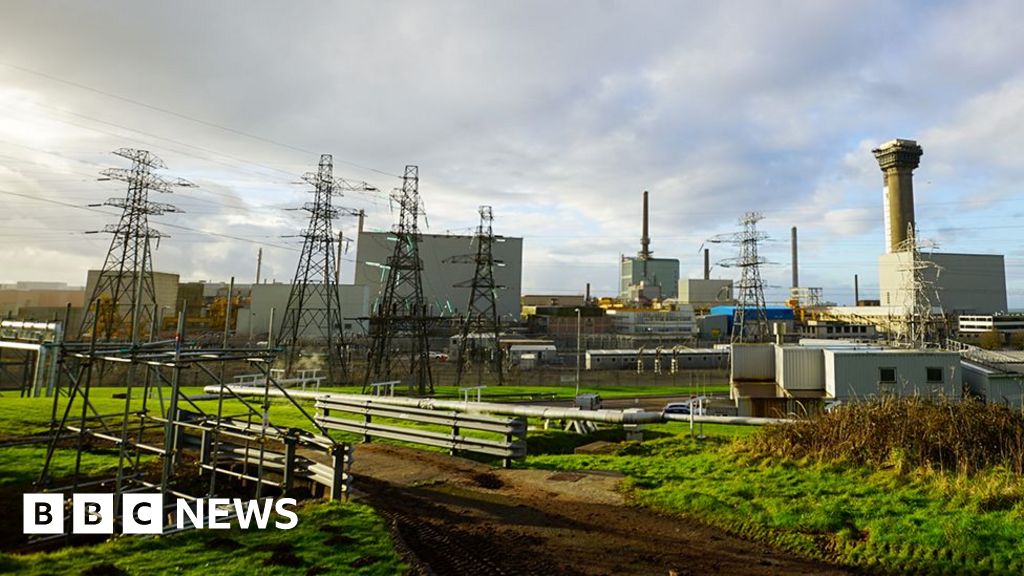
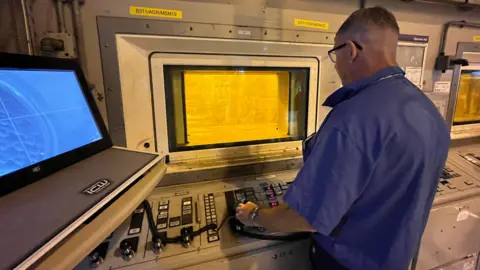 Kevin Church/BBC
Kevin Church/BBCA repeating tone – blip, blip, blip – is the audible reminder that we are in one of the most hazardous nuclear sites in the world: Sellafield.
That sound – pulsing from speakers inside the cavernous fuel-handling plant – is a signal that everything is functioning as it should.
That is comforting because Sellafield, in Cumbria, is the temporary home to the vast majority of the UK’s radioactive nuclear waste, as well as the world’s largest stockpile of plutonium.
That waste is the product of reactions that drive the UK’s nuclear power stations and it is highly radioactive.
It releases energy that can penetrate and damage the cells in our bodies, and “it remains hazardous for 100,000 years”, explains Claire Corkhill, professor of radioactive waste management at University of Bristol.
Sellafield is filling up – and experts say we have no choice but to find somewhere new to keep this material safe.
Nuclear power is also part of the government’s stated mission for ”clean power by 2030”. More nuclear power means more nuclear waste.

Inside Sellafield’s fuel-handling plant, we watch from behind one metre-thick, lead-lined glass as operators remotely control robotic arms.
They manoeuvre joysticks on what look like large retro game-controllers, as the arms pull used nuclear fuel rods – still glowing hot and highly radioactive – from the heavy metal containers in which they arrived.
This complex operation never stops. Sellafield runs 24 hours a day with 11,000 staff. It costs more than £2bn per year to keep the site going, and it comprises more than 1,000 buildings, connected by 25 miles of road.
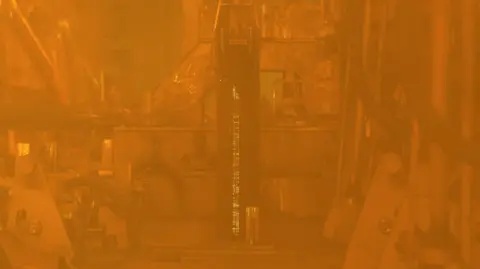 Kevin Church/BBC
Kevin Church/BBCHowever, in recent years, doubts have been raised about the site’s security and physical integrity.
One of its oldest waste storage silos is currently leaking radioactive liquid into the ground. That is a “recurrence of a historic leak” that Sellafield Ltd, the company that operates the site, says first started in the 1970s.
Sellafield has also faced questions about its working culture and adherence to safety rules. The company is currently awaiting sentencing after it pleaded guilty, in June, to charges related to cyber-security failings.
An investigation by the Guardian revealed that the site’s systems had been hacked, although the Office for Nuclear Regulation said there was “no evidence that any vulnerabilities had been exploited” by the hackers.
 Getty Images
Getty ImagesAll of this has cast a shadow over an operation that, as well as taking in newly created nuclear waste, also houses several decades worth of much older radioactive material.
The site no longer produces or reprocesses any nuclear material, but this is where the race began to produce plutonium for nuclear weapons at the height of the Cold War.
“It was the dawn of the nuclear age,” says Roddy Miller, Sellafield’s operations director. “But because it was a race, not a lot of thought was given to the long-term safe storage of the waste materials that were produced.”
The leaking storage silo, which was built in the 1960s, is just one of the buildings that now has to be emptied so the material inside can go into more modern silos. The building was only ever designed to be filled, and Sellafield says its plans to clear the site and demolish the building are the safest option.
The site’s head of retrievals, Alyson Armett, points out that without a “permanent solution” for the nuclear waste, the plans to decommission could be delayed.
The current plan for that permanent solution is to bury the waste deep underground.
A complicated search – both scientifically and politically – is currently on for somewhere to lock it away from humanity permanently.
“We need to isolate it from future populations or even civilisations, that’s the timescale we’re looking at,” says Prof Corkhill.
She studies how radioactive waste material can be made safe for extremely long-term storage, and is searching for the most stable, inert substance that nuclear waste could be “baked into”.
“We turn it into a solid – glass, ceramic or a material that’s just like the rocks that the uranium originally came from,” she explains. At Sellafield, the highest level of radioactive waste is stabilised in a similar way before it is stored on-site.
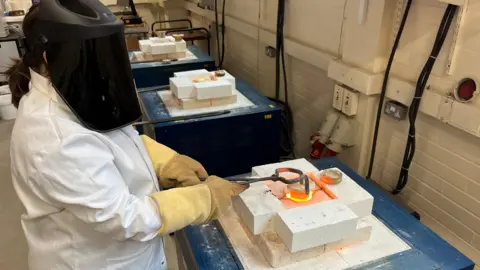 Kevin Church/BBC
Kevin Church/BBCThe plan for permanent, underground storage is to contain that solid waste in a Russian doll-like series of barriers. The glass, encased in steel, will be shielded in concrete, then buried beneath the Earth‘s own barriers – layers of solid rock.
The question is, where will that facility be?
‘The waste is already here’
Six years ago, communities in England and Wales were asked to come forward if they were willing to consider having a disposal facility built near their town or village.
Potential sites will need the ideal geology – enough solid rock to create that permanent barrier. However, they also need something that might be more difficult – a willing community.
There are financial incentives for communities to take part in this discussion. So far, five have come forward. Two have already been ruled out. Allerdale in Cumbria was deemed unsuitable because there was not enough solid bedrock. Then, in September, councillors in South Holderness, in Yorkshire, withdrew after a series of local protests.
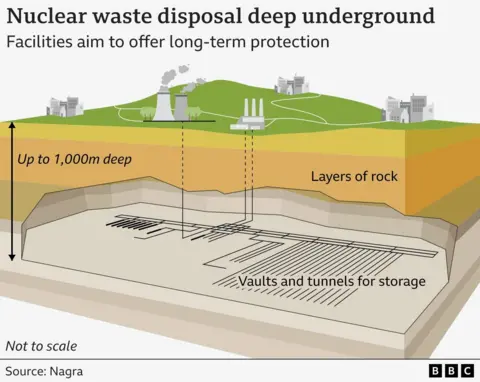
Government scientists are assessing the remaining three communities that are currently in the running. Geologists have been carrying out seismic testing – looking for that all-important impermeable rock.
One of the communities being considered is very close to the Sellafield site in West Cumbria, at Seascale.
Local councillor David Moore says the industrial complex is “just down the road, and it’s the biggest employer in the area”.
He adds: “I think that’s why conversation here’s different. We’re already the hosts of the waste. And we all want to find it a safer location.
“I have seven grandchildren who live in this community, and I want them to live in a safe environment.”
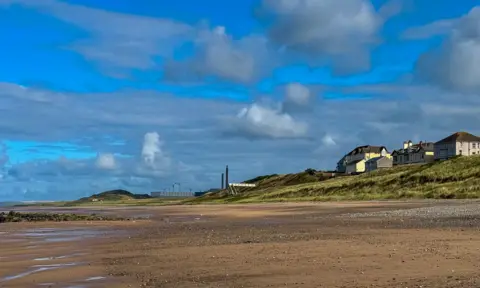 Kate Stephens/BBC
Kate Stephens/BBCIt is not yet clear if Mid Copeland, the area under consideration that includes Seascale, will have the right rock. The survey and consultation here – and in the other locations being considered – are in their early stages and scheduled to last at least a decade.
In the meantime, the conversation goes on and each community being considered for a geological disposal facility (GDF) now receives about £1m a year in investment while initial scientific tests are carried out.
Mr Moore is part of a committee called a GDF partnership. It includes local residents, local government and representatives of Nuclear Waste Services, which is the government body behind this project.
These partnerships aim to keep the process transparent and ensure local people are well-informed. They also decide how the money is spent.
 Victoria Gill/BBC
Victoria Gill/BBCIf a GDF is built here, Mr Moore says, there will be billions of pounds invested in the area. “If we’re going to host this on behalf of the UK, the community should benefit,” he says.
Also still on the shortlist are South Copeland, again on the Cumbrian coast, and a site on the east coast in Lincolnshire, where there have been a number of peaceful, but angry, protests.
On Halloween 2021 in Theddlethorpe, one of the local villages, several residents used their gardens to put up garish anti-nuclear dump scarecrows, inspired by an idea from pressure group the Guardians of the East Coast, which is campaigning against the disposal facility.
Ken Smith, from nearby Mablethorpe, is a member of both the campaign group and the local GDF partnership.
He thinks the government’s approach to finding a nuclear waste disposal site “stinks”.
Mr Smith is concerned that the voices of those most affected might not be heard and says it is unclear how local opinion will be measured at the end of the consultation.
The Department for Energy Security and Net Zero says a GDF will provide “safe and long-term disposal of the most hazardous radioactive waste”.
Prof Corkhill is convinced that a GDF is the safest solution. “We extract uranium from the rocks in the ground, we get energy from them and [this disposal facility essentially means] they’re returned back to the ground again,” she says.
“That uranium has been present in those rocks for billions of years. It’s been pushed and pulled, squeezed and heated, exposed to water and air. But the uranium is still safely locked up.”
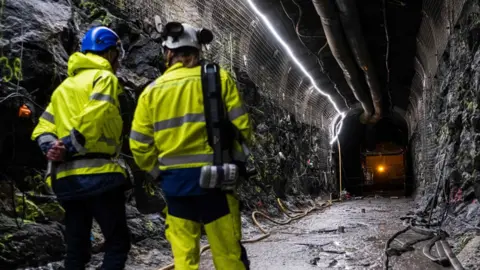 Getty Images
Getty ImagesIn Finland, a facility, called Onkalo, has already been built, and could receive its first nuclear waste within the next year.
Locations for three other sites around the world have also been chosen, in Switzerland, Sweden and France. They are at various stages of development.
In the UK, the search, studies and consultations continue. Only when those have been concluded and some kind of final assessment of community support, like a referendum, has taken place will construction of a GDF begin. The earliest that any waste could be put inside it is estimated to be during the 2050s.
Until then, it will continue to be stored and managed at Sellafield.
“We’ve benefited from nuclear energy in this country for 70 years, but we are still a long way behind cleaning up the legacy that has been left behind,” says Prof Corkhill.
“When we move to thinking about a new generation of nuclear power, we need to think about the waste now.”
Science & Environment
Horseshoe crabs: Ancient creatures who are a medical marvel
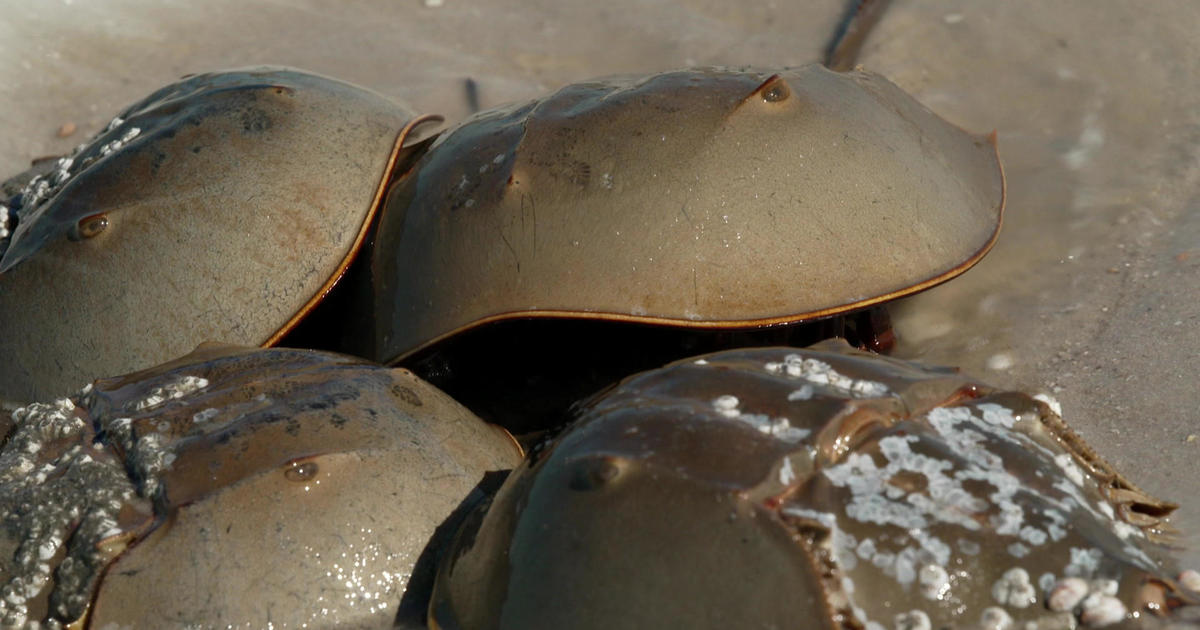
Watch CBS News
Be the first to know
Get browser notifications for breaking news, live events, and exclusive reporting.
Science & Environment
SpaceX to launch bitcoin entrepreneur and three crewmates on flight around Earth’s poles

A blockchain entrepreneur, a cinematographer, a polar adventurer and a robotics researcher plan to fly around Earth’s poles aboard a SpaceX Crew Dragon capsule by the end of the year, becoming the first humans to observe the ice caps and extreme polar environments from orbit, SpaceX announced Monday.
The historic flight, launched from the Kennedy Space Center in Florida, will be commanded by Chun Wang, a wealthy bitcoin pioneer who founded f2pool and stakefish, “which are among the largest Bitcoin mining pools and Ethereum staking providers,” the crew’s website says.
“Wang aims to use the mission to highlight the crew’s explorational spirit, bring a sense of wonder and curiosity to the larger public and highlight how technology can help push the boundaries of exploration of Earth and through the mission’s research,” SpaceX said on its website.
Wang’s crewmates are Norwegian cinematographer Jannicke Mikkelsen, Australian adventurer Eric Philips and Rabea Rogge, a German robotics researcher. All four have an interest in extreme polar environments and plan to carry out related research and photography from orbit.
The mission, known as “Fram2” in honor of a Norwegian ship used to explore both the Arctic and Antarctic regions, will last three to five days and fly at altitudes between about 265 and 280 miles.
“This looks like a cool & well thought out mission. I wish the @framonauts the best on this epic exploration adventure!” tweeted Jared Isaacman, the billionaire philanthropist who charted the first private SpaceX mission — Inspiration4 — and who plans to blast off on a second flight — Polaris Dawn — later this month.
The flights “showcase what commercial missions can achieve thanks to @SpaceX’s reusability and NASA’s vision with the commercial crew program,” Isaacman said. “All just small steps towards unlocking the last great frontier.”
Like the Inspiration4 mission before them, Wang and his crewmates will fly in a Crew Dragon equipped with a transparent cupola giving them a picture-window view of Earth below and deep space beyond.
No astronauts or cosmonauts have ever viewed Earth from the vantage point of a polar orbit, one tilted, or inclined, 90 degrees to the equator. Such orbits are favored by spy satellites, weather stations and commercial photo-reconnaissance satellites because they fly over the entire planet as it rotates beneath them.
The high-inclination record for piloted flight was set in the early 1960s by Soviet Vostok spacecraft launched into orbits inclined 65 degrees. The U.S. record was set by a space shuttle mission launched in 1990 that carried out a classified military mission in an orbit tilted 62 degrees with respect to the equator.
The International Space Station never flies beyond 51.6 degrees north and south latitude. NASA planned to launch a space shuttle on a classified military mission around the poles in 1986, but the flight was canceled in the wake of the Challenger disaster.
“The North and South Poles are invisible to astronauts on the International Space Station, as well as to all previous human spaceflight missions except for the Apollo lunar missions but only from far away,” the Fram2 website says. “This new flight trajectory will unlock new possibilities for human spaceflight.”
SpaceX has launched 13 piloted missions carrying 50 astronauts, cosmonauts and private citizens to orbit in nine NASA flights to the space station, three commercial visits to the lab and the Inspiration4 mission chartered by Isaacman.
Isaacman and three crewmates plan to blast off Aug. 26 on another fully commercial flight, this one featuring the first civilian spacewalks. NASA plans to launch its next Crew Dragon flight to the space station around Sept. 24.
Science & Environment
Giant “flying” Joro spiders love big cities. A new study found their ability to chill out in stressful situations may be why
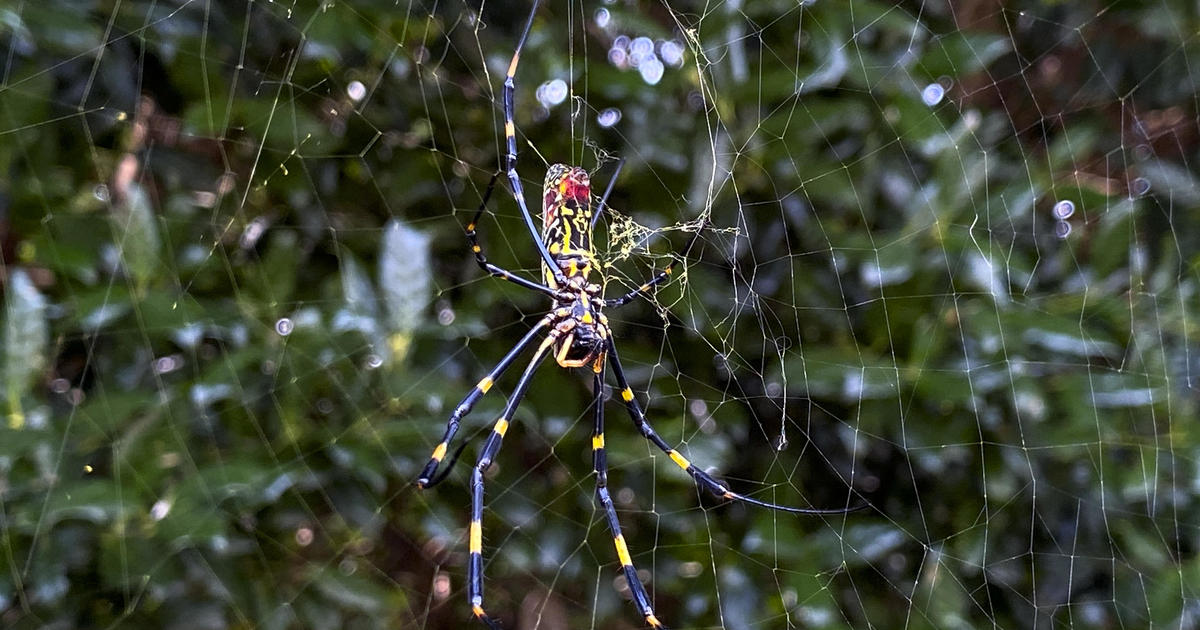
The saga of the large invasive Joro spiders that parachute through the air isn’t over. A new study found that the critters with 4-inch-long legs are truly built differently, with hearts that are able to withstand the loud and bustling noises of big cities.
University of Georgia researcher Andy Davis made the discovery while conducting cardiac stress tests on Joro spiders and their cousin, the golden silk spider. The research, published in Physiological Entomology on Monday, found that the species know how to chill out and stay calm when put in heart rate-raising situations.
The Joro spider, also known as Trichonephila clavata, “is known for making webs not only in natural green spaces but also in cities and towns, often on buildings and human dwellings,” the study says. “The stress reactions of Trichonephila spiders could be characterized as ‘even-tempered,’ which may factor into their ability to live in habitats with frequent disturbances.”
Davis and his team evaluated the physiological reactions of Joro spiders and golden silk spiders and compared them to those of another pair of similarly-sized species that are related to each other, garden spiders and banded garden spiders.
Researchers recorded baseline heart rates of the arachnids while they were resting and inactive, and then recorded their heart rates after restraining them under electronic sensors for 10 minutes.
“When subjected to the novel restraint stress, heart rates of all spider species became elevated, which is an expected reaction that other spider researchers have noted,” the study says. “However, there were differences among species in the magnitude of this elevation, and of how the responses progressed during the 10 min period.”
The garden spiders, both of which belong to the Argiope genus, showed “distinct periods of fluctuations during the restraint” and were even found to struggle against the restraints, researchers said. Joro spiders and their golden silk cousins, on the other hand, were “less variable and more even.” They were also observed entering a state of thanatosis for more than an hour after stressors, meaning they essentially froze up during that time.
The tests “are beginning to paint a picture of how the invasive Joro spider and its cousin, the golden silk spider, have a unique way of tolerating novel stressors, which may be the reason for their ability to occupy anthropogenic landscapes,” researchers said, noting that other spider species in their family line could share this trait, although that would need further investigation.
Joro spiders have been making headlines for years as they continue to spread up the East Coast. Originally from Asia, the spiders are believed to have been first introduced to north Georgia around 2010. They have since been found across nearly a dozen other states. In December, Davis told The New York Times that New York is “right in the middle of where they like to be.” It’s been predicted that they could pop up in the New York tri-state area this summer, although no reports of such have been made.
“They seem to be OK with living in a city,” he told the paper, adding that they’ve been seen hanging out on street lamps and telephone poles, where “regular spiders wouldn’t be caught dead in.”
The latest findings may not definitively prove that the spiders’ relaxed demeanor is the reason for “their affinity for urban settings,” the study says, adding that more research is needed. It does, however, bolster Davis’ research from February, which also found that Joro spiders don’t necessarily mind the increased noise and vibrations that come with city living.
“These Joro webs are everywhere in the fall, including right next to busy roads, and the spiders seem to be able to make a living there. For some reason, these spiders seem urban tolerant,” Davis said of his earlier research.
UGA student and co-author of that study, Alexa Schultz, agreed, saying, “It looks like Joro spiders are not going to shy away from building a web under a stoplight or an area where you wouldn’t imagine a spider to be.”
But don’t worry — while the spiders are venomous, they don’t pose a danger to humans, although they may elevate your heart rate more than you elevate theirs.
Science & Environment
New volcanic eruption in Iceland brings video of lava spewing from miles-long fissure on Reykjanes peninsula
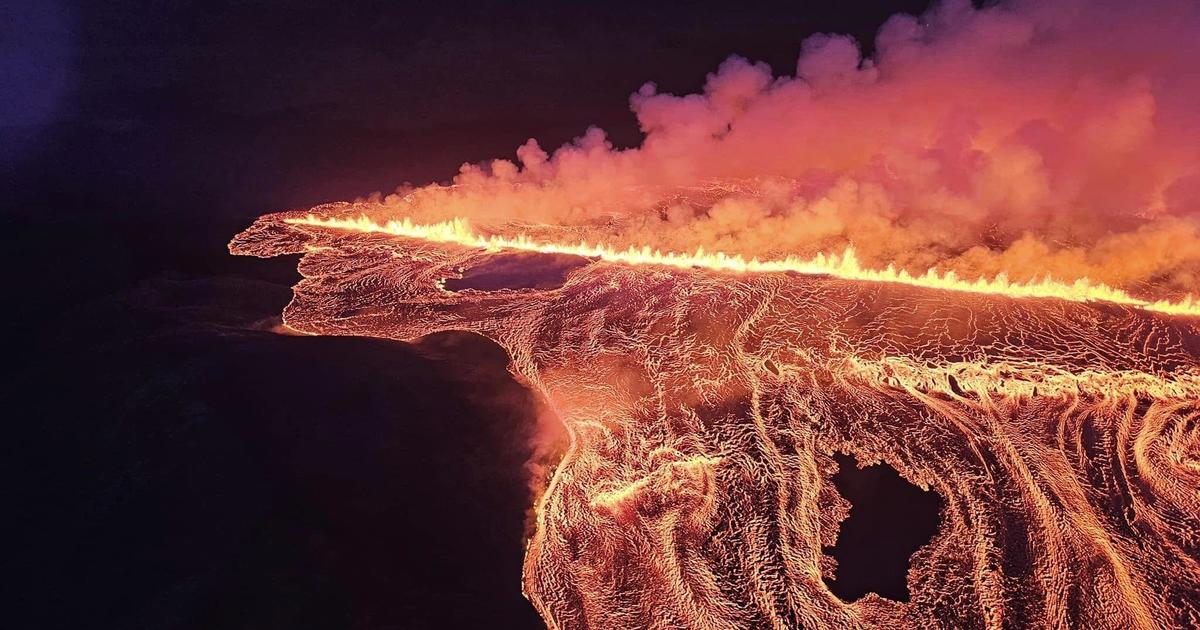
Reykjavik — Icelandic authorities said Friday that a second fissure had formed on the southwestern Reykjanes peninsula after lava started spewing forth for the sixth time in the region since December. After weeks of warnings, the Icelandic Meteorological Office (IMO) said Thursday that a new eruption had started at 9:26 p.m. (5:26 p.m. Eastern) that evening, following a series of earthquakes.
Video showed orange lava bursting out of a long fissure, which the IMO estimated to be 2.4 miles.
Early Friday, the IMO announced on social media that a second fissure had opened up to the north of the original one, but it said the volcanic activity mostly remained on the first crack.
The weather agency, which also monitors geological events, had previously reported that there was “considerable seismic activity” at the northern end of the fissure.
About an hour after the eruption started an earthquake with a magnitude of 4.1 was recorded in the area.
This is the sixth eruption to hit the area since December, coming just two months after the end of a previous eruption that lasted more than three weeks.
The chief of police of the Sudurnes region, Ulfar Ludviksson, told Icelandic media that the evacuation of the nearby fishing village of Grindavik had gone well.
He added that 22 or 23 houses in the village were currently occupied. Most of Grindavik’s 4,000 residents had evacuated in November, prior to a December eruption, and while residents have since been allowed to return in between eruptions, only a few have opted to stay overnight.
According to the IMO, there was no lava flowing towards Grindavik in the latest eruption.
Iceland’s famed Blue Lagoon thermal spa tourist attraction said late Thursday that it had taken “the precautionary measure of evacuating and temporarily closing all our operational units.”
The Reykjanes peninsula had not experienced an eruption for eight centuries until March 2021. Further eruptions occurred in August 2022 and in July and December 2023, leading volcanologists to warn that a new era of seismic activity had begun in the region.
Iceland is home to 33 active volcano systems, the highest number in Europe. It straddles the Mid-Atlantic Ridge, a crack in the ocean floor separating the Eurasian and North American tectonic plates.
Science & Environment
Matching dinosaur footprints found more than 3,700 miles apart, on different continents
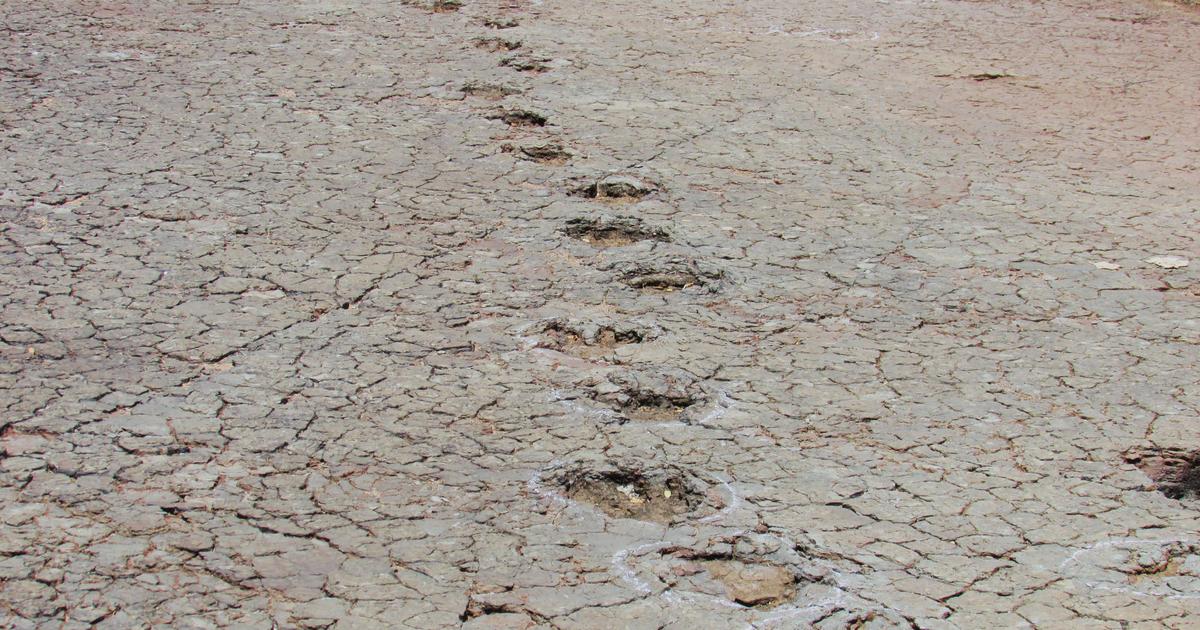
A team of paleontologists found matching dinosaur footprints on what are now two different continents, separated by thousands of miles of ocean.
The footprints, dating back to the Early Cretaceous period, were found in Brazil and in Cameroon, researchers wrote in a study published Monday by the New Mexico Museum of Natural History & Science. The discovery shows where land-dwelling dinosaurs were able to cross freely between South America and Africa before the two continents split apart millions of years ago.
Land shifts
The more than 260 footprints researchers studied were found impressed into mud and silt along ancient rivers and lakes, with more than 3,700 miles separating the ones in South America and Africa, according to the study. Paleontologists determined they were similar in age, shape and in geological and plate tectonic contexts.
Dinosaurs made the tracks 120 million years ago on a single supercontinent known as Gondwana, which had broken off from the larger landmass of Pangea — once the world’s only continent, Southern Methodist University paleontologist Louis Jacobs said.
“One of the youngest and narrowest geological connections between Africa and South America was the elbow of northeastern Brazil nestled against what is now the coast of Cameroon along the Gulf of Guinea,” Jacobs, the lead study author, said. “The two continents were continuous along that narrow stretch, so that animals on either side of that connection could potentially move across it.”
The continents now known as Africa and South America started to split around 140 million years ago, researchers said. The south Atlantic Ocean eventually filled the void.
Basins formed as the continents pulled apart; rivers flowed and lakes formed in those basins, Jacobs said. The basins where the footprints were discovered can be found on both sides of the split.
What we know about the dinosaurs
Most of the footprints were made by three-toed theropods, a group of carnivorous dinosaurs, researchers said. There were also prints left behind by sauropods or ornithischians.
“Plants fed the herbivores and supported a food chain,” Jacobs said. “Muddy sediments left by the rivers and lakes contain dinosaur footprints, including those of meat-eaters, documenting that these river valleys could provide specific avenues for life to travel across the continents 120 million years ago.”
Science & Environment
SpaceX launches 21 Starlink satellites, but rocket’s first stage crashes on landing barge
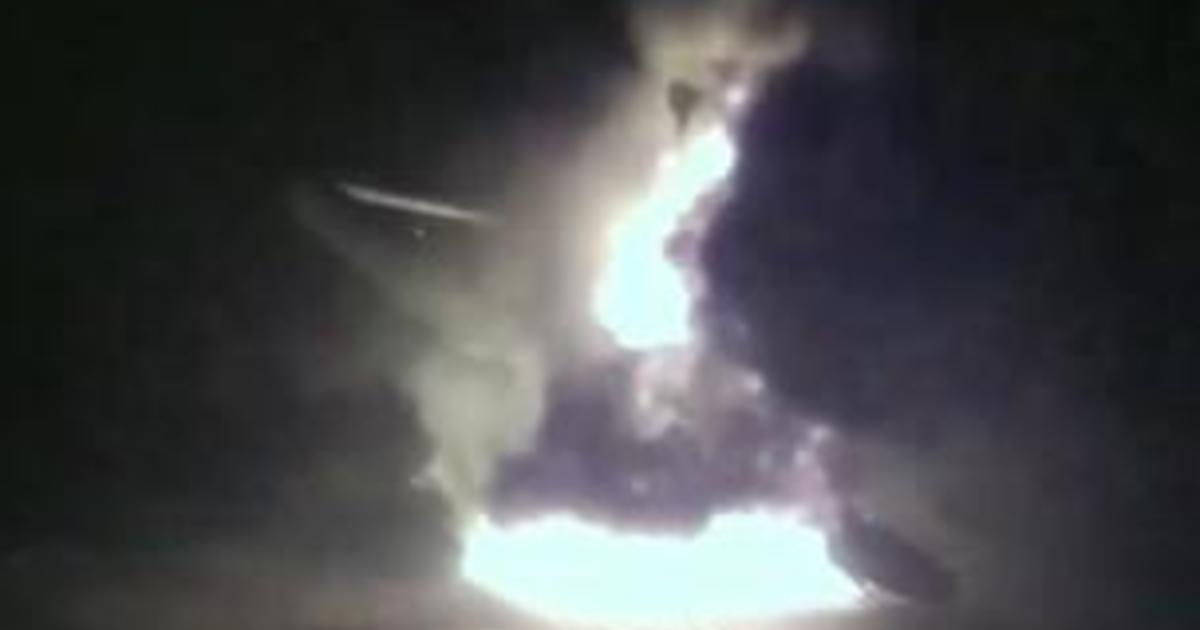
After standing down from the piloted Polaris Dawn launch late Tuesday, SpaceX shifted gears and pressed ahead with plans for back-to-back launches of Starlink internet satellites early Wednesday, one from Florida and the other from California.
But the second flight was called off after the first stage used in the Florida launch toppled into the Atlantic Ocean and broke apart while attempting to land on a SpaceX droneship stationed several hundred miles northeast of Cape Canaveral. The landing mishap ended a string of 267 successful booster recoveries dating back to February 2021.
The Falcon 9’s second stage, meanwhile, successfully carried 21 Starlink satellites to their planned orbit.
The first stage landing appeared normal until the moment of touchdown when more flames than usual were visible around the base of the rocket as it neared the deck. A landing leg immediately collapsed on touchdown and the booster, obscured by fire and smoke, tipped over the side of the landing barge into the Atlantic.
“After a successful ascent, Falcon 9’s first stage booster tipped over following touchdown on the A Shortfall of Gravitas droneship,” SpaceX said on the social media site X. “Teams are assessing the booster’s flight data and status.”
It was first stage B1062’s 23rd and what turned out to be final launch and landing, a new reuse record. SpaceX is working toward certifying its Falcon 9 first stages for up to 40 flights each.
Shortly after the Starlinks launched from Florida were deployed, SpaxeX called off the California launch, planned for 5:58 a.m. EDT, to give engineers more time to review telemetry and video footage, on the lookout for any signs of trouble that could affect other rockets.
“Standing down from our second @Starlink launch of the night to give the team time to review booster landing data from the previous launch,” SpaceX said on X. “A new target launch date will be shared once available.”
Here are updated Falcon 9 stats through through this morning’s Florida launch:
Total Falcon 9 launches to date: 367
Total Falcon Heavy launches to date: 10
Total Super Heavy/Starship launches to date: 4
Falcon 9/Heavy launches this year: 83 (82 F9s, 1 FH)
In-flight Falcon 9/Heavy failures: 2 (06/28/15, 07/11/24)
Successful Falcon 9/Heavy launches in a row: 13
Most successful flights in a row: 344 (between 6/28/15 and 07/11/24)
Starlink launches to date: 190 (181 dedicated flights, 9 mixed payloads)
Starlink launches this year: 58
Starlink satellites launched to date: 6,920
Starlinks with direct-to-cell capability: 136
Starlinks presumed to be working going into latest launch: 6,269*
Payloads launched to orbit this year by SpaceX: 1,548
First stage fleet leader: B1062, 23 flights (booster lost on landing)
California landings to date: 20
Florida landings to date: 54
Droneship landings to date: 267 (not counting today’s flight)
Successful booster landings overall: 341
Successful booster landings in a row: 267 (before today’s flight)
*Source: https://planet4589.org/space/con/star/stats.html
-

 Sport7 hours ago
Sport7 hours agoJoshua vs Dubois: Chris Eubank Jr says ‘AJ’ could beat Tyson Fury and any other heavyweight in the world
-

 News1 day ago
News1 day agoYou’re a Hypocrite, And So Am I
-

 Technology6 hours ago
Technology6 hours agoiPhone 15 Pro Max Camera Review: Depth and Reach
-

 CryptoCurrency7 hours ago
CryptoCurrency7 hours agoDecentraland X account hacked, phishing scam targets MANA airdrop
-

 CryptoCurrency7 hours ago
CryptoCurrency7 hours agoBitcoin miners steamrolled after electricity thefts, exchange ‘closure’ scam: Asia Express
-

 CryptoCurrency7 hours ago
CryptoCurrency7 hours agoSEC asks court for four months to produce documents for Coinbase
-

 News8 hours ago
News8 hours agoIsrael strikes Lebanese targets as Hizbollah chief warns of ‘red lines’ crossed
-

 Sport7 hours ago
Sport7 hours agoUFC Edmonton fight card revealed, including Brandon Moreno vs. Amir Albazi headliner
-

 CryptoCurrency6 hours ago
CryptoCurrency6 hours agoEthereum is a 'contrarian bet' into 2025, says Bitwise exec
-

 Science & Environment10 hours ago
Science & Environment10 hours agoHow one theory ties together everything we know about the universe
-

 CryptoCurrency7 hours ago
CryptoCurrency7 hours agoSEC settles with Rari Capital over DeFi pools, unregistered broker activity
-

 News5 hours ago
News5 hours agoBrian Tyree Henry on voicing young Megatron, his love for villain roles
-

 Science & Environment21 hours ago
Science & Environment21 hours agoQuantum time travel: The experiment to ‘send a particle into the past’
-

 Science & Environment7 hours ago
Science & Environment7 hours agoWe may have spotted a parallel universe going backwards in time
-

 CryptoCurrency7 hours ago
CryptoCurrency7 hours ago2 auditors miss $27M Penpie flaw, Pythia’s ‘claim rewards’ bug: Crypto-Sec
-

 CryptoCurrency7 hours ago
CryptoCurrency7 hours agoArthur Hayes’ ‘sub $50K’ Bitcoin call, Mt. Gox CEO’s new exchange, and more: Hodler’s Digest, Sept. 1 – 7
-

 CryptoCurrency7 hours ago
CryptoCurrency7 hours agoTreason in Taiwan paid in Tether, East’s crypto exchange resurgence: Asia Express
-

 CryptoCurrency7 hours ago
CryptoCurrency7 hours agoLeaked Chainalysis video suggests Monero transactions may be traceable
-

 CryptoCurrency7 hours ago
CryptoCurrency7 hours agoJourneys: Robby Yung on Animoca’s Web3 investments, TON and the Mocaverse
-

 CryptoCurrency7 hours ago
CryptoCurrency7 hours agoLouisiana takes first crypto payment over Bitcoin Lightning
-

 CryptoCurrency7 hours ago
CryptoCurrency7 hours agoAre there ‘too many’ blockchains for gaming? Sui’s randomness feature: Web3 Gamer
-

 CryptoCurrency7 hours ago
CryptoCurrency7 hours agoCrypto whales like Humpy are gaming DAO votes — but there are solutions
-

 CryptoCurrency7 hours ago
CryptoCurrency7 hours agoHelp! My parents are addicted to Pi Network crypto tapper
-

 CryptoCurrency7 hours ago
CryptoCurrency7 hours agoFive crypto market predictions that haven’t come true — yet
-

 CryptoCurrency7 hours ago
CryptoCurrency7 hours ago$12.1M fraud suspect with ‘new face’ arrested, crypto scam boiler rooms busted: Asia Express
-

 CryptoCurrency7 hours ago
CryptoCurrency7 hours ago‘Everything feels like it’s going to shit’: Peter McCormack reveals new podcast
-

 CryptoCurrency7 hours ago
CryptoCurrency7 hours agoSEC sues ‘fake’ crypto exchanges in first action on pig butchering scams
-

 CryptoCurrency7 hours ago
CryptoCurrency7 hours agoFed rate cut may be politically motivated, will increase inflation: Arthur Hayes
-

 CryptoCurrency7 hours ago
CryptoCurrency7 hours agoBinance CEO says task force is working ‘across the clock’ to free exec in Nigeria
-

 CryptoCurrency7 hours ago
CryptoCurrency7 hours agoBitcoin price hits $62.6K as Fed 'crisis' move sparks US stocks warning
-

 CryptoCurrency7 hours ago
CryptoCurrency7 hours agoCZ and Binance face new lawsuit, RFK Jr suspends campaign, and more: Hodler’s Digest Aug. 18 – 24
-

 CryptoCurrency7 hours ago
CryptoCurrency7 hours agoCardano founder to meet Argentina president Javier Milei
-

 CryptoCurrency7 hours ago
CryptoCurrency7 hours agoCertiK Ventures discloses $45M investment plan to boost Web3
-

 CryptoCurrency7 hours ago
CryptoCurrency7 hours agoMemecoins not the ‘right move’ for celebs, but DApps might be — Skale Labs CMO
-

 CryptoCurrency7 hours ago
CryptoCurrency7 hours agoDorsey’s ‘marketplace of algorithms’ could fix social media… so why hasn’t it?
-

 CryptoCurrency7 hours ago
CryptoCurrency7 hours agoTelegram bot Banana Gun’s users drained of over $1.9M
-

 CryptoCurrency7 hours ago
CryptoCurrency7 hours agoLow users, sex predators kill Korean metaverses, 3AC sues Terra: Asia Express
-

 CryptoCurrency7 hours ago
CryptoCurrency7 hours agoBlockdaemon mulls 2026 IPO: Report
-

 News5 hours ago
News5 hours ago“Beast Games” contestants sue MrBeast’s production company over “chronic mistreatment”
-

 Technology3 days ago
Technology3 days agoYouTube restricts teenager access to fitness videos
-

 Science & Environment10 hours ago
Science & Environment10 hours ago‘Running of the bulls’ festival crowds move like charged particles
-

 Politics21 hours ago
Politics21 hours agoWhat is the House of Lords, how does it work and how is it changing?
-

 MMA7 hours ago
MMA7 hours agoUFC’s Cory Sandhagen says Deiveson Figueiredo turned down fight offer
-

 MMA7 hours ago
MMA7 hours agoDiego Lopes declines Movsar Evloev’s request to step in at UFC 307
-

 Football6 hours ago
Football6 hours agoNiamh Charles: Chelsea defender has successful shoulder surgery
-

 Football6 hours ago
Football6 hours agoSlot's midfield tweak key to Liverpool victory in Milan
-

 Fashion Models6 hours ago
Fashion Models6 hours agoMiranda Kerr nude
-

 Politics6 hours ago
Politics6 hours agoLabour MP urges UK government to nationalise Grangemouth refinery
-

 Science & Environment10 hours ago
Science & Environment10 hours agoRethinking space and time could let us do away with dark matter
-

 Entertainment5 hours ago
Entertainment5 hours ago“Jimmy Carter 100” concert celebrates former president’s 100th birthday
-

 Science & Environment18 hours ago
Science & Environment18 hours agoSunlight-trapping device can generate temperatures over 1000°C
-

 News5 hours ago
News5 hours agoJoe Posnanski revisits iconic football moments in new book, “Why We Love Football”
-

 Science & Environment20 hours ago
Science & Environment20 hours agoQuantum to cosmos: Why scale is vital to our understanding of reality
-

 Technology3 days ago
Technology3 days agoTrump says Musk could head ‘government efficiency’ force
-

 Science & Environment18 hours ago
Science & Environment18 hours agoDoughnut-shaped swirls of laser light can be used to transmit images
-
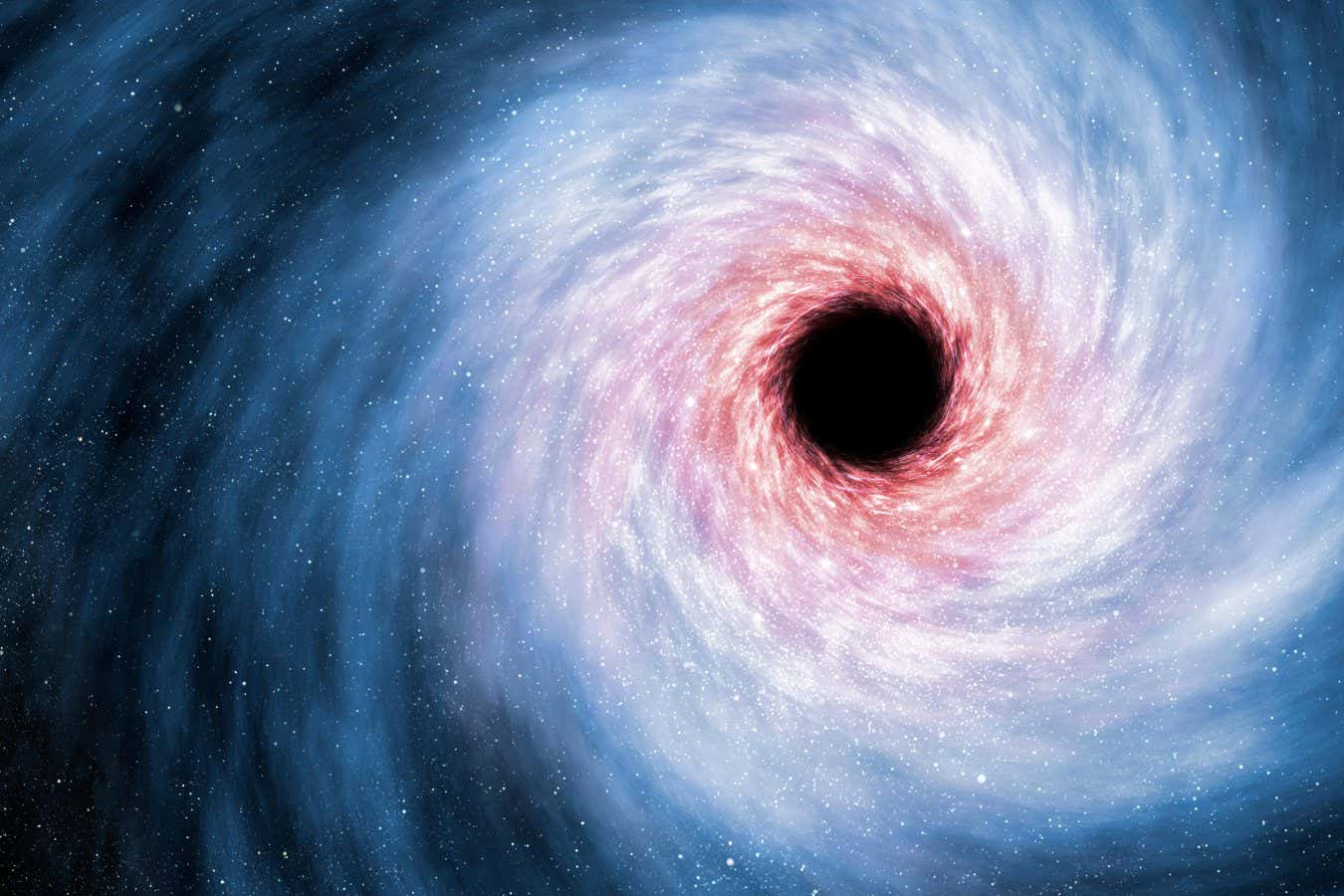
 Science & Environment16 hours ago
Science & Environment16 hours agoBlack holes scramble information – but may not be the best at it
-

 Science & Environment16 hours ago
Science & Environment16 hours agoThe galactic anomalies hinting dark matter is weirder than we thought
-

 CryptoCurrency7 hours ago
CryptoCurrency7 hours agoTelegram CEO cannot leave France, OpenSea receives Wells notice, and more: Hodler’s Digest, Aug. 25 – 31
-

 CryptoCurrency7 hours ago
CryptoCurrency7 hours agoSolana unveils new Seeker device, says it’s not just a ‘memecoin phone’
-

 CryptoCurrency7 hours ago
CryptoCurrency7 hours agoCrypto scammers orchestrate massive hack on X but barely made $8K
-

 CryptoCurrency7 hours ago
CryptoCurrency7 hours agoBitcoiners are ‘all in’ on Trump since Bitcoin ’24, but it’s getting risky
-

 CryptoCurrency7 hours ago
CryptoCurrency7 hours agoReal-world asset tokenization is the crypto killer app — Polygon exec
-

 Science & Environment10 hours ago
Science & Environment10 hours agoJupiter’s stormy surface replicated in lab
-

 Science & Environment10 hours ago
Science & Environment10 hours agoFuture of fusion: How the UK’s JET reactor paved the way for ITER
-
Politics10 hours ago
Owen Paterson loses ECHR appeal against report that preceded downfall | Owen Paterson
-

 CryptoCurrency7 hours ago
CryptoCurrency7 hours agoDuckDuckGo ranks Etherscan phishing websites in top results
-

 CryptoCurrency7 hours ago
CryptoCurrency7 hours agoBitcoin bull rally far from over, MetaMask partners with Mastercard, and more: Hodler’s Digest Aug 11 – 17
-

 CryptoCurrency7 hours ago
CryptoCurrency7 hours agoVonMises bought 60 CryptoPunks in a month before the price spiked: NFT Collector
-

 CryptoCurrency7 hours ago
CryptoCurrency7 hours agoVitalik tells Ethereum L2s ‘Stage 1 or GTFO’ — Who makes the cut?
-

 CryptoCurrency7 hours ago
CryptoCurrency7 hours agoEthereum falls to new 42-month low vs. Bitcoin — Bottom or more pain ahead?
-
Business7 hours ago
Thames Water seeks extension on debt terms to avoid renationalisation
-
Business6 hours ago
How Labour donor’s largesse tarnished government’s squeaky clean image
-
Business5 hours ago
UK hospitals with potentially dangerous concrete to be redeveloped
-
Business5 hours ago
Axel Springer top team close to making eight times their money in KKR deal
-

 News5 hours ago
News5 hours agoSean “Diddy” Combs denied bail again in federal sex trafficking case
-

 News5 hours ago
News5 hours agoSean “Diddy” Combs denied bail again in federal sex trafficking case in New York
-

 News5 hours ago
News5 hours agoBrian Tyree Henry on his love for playing villains ahead of “Transformers One” release
-

 News5 hours ago
News5 hours agoBrian Tyree Henry on voicing young Megatron, his love for villain roles
-

 News9 hours ago
News9 hours agoPolice chief says Daniel Greenwood 'used rank to pursue junior officer'
-

 News9 hours ago
News9 hours agoChurch same-sex split affecting bishop appointments
-

 Technology2 days ago
Technology2 days agoIs carbon capture an efficient way to tackle CO2?
-

 Politics2 days ago
Politics2 days agoTrump says he will meet with Indian Prime Minister Narendra Modi next week
-

 Science & Environment10 hours ago
Science & Environment10 hours agoPhysicists have worked out how to melt any material
-

 Politics22 hours ago
Politics22 hours agoKeir Starmer facing flashpoints with the trade unions
-

 CryptoCurrency2 days ago
CryptoCurrency2 days agoBitcoin reclaims $60K and ‘this time is different,’ says analyst
-

 Health & fitness2 days ago
Health & fitness2 days agoWhy you should take a cheat day from your diet, and how many calories to eat
-

 Technology8 hours ago
Technology8 hours agoFivetran targets data security by adding Hybrid Deployment
-
News2 days ago
Why is XRP price up today?
-

 Science & Environment1 day ago
Science & Environment1 day agoElon Musk’s SpaceX contracted to destroy retired space station
-

 Science & Environment2 days ago
Science & Environment2 days agoOur reality seems to be compatible with a quantum multiverse
-
News7 hours ago
Freed Between the Lines: Banned Books Week
-

 Technology3 days ago
Technology3 days agoMusician charged with using bots to boost streaming revenue
-
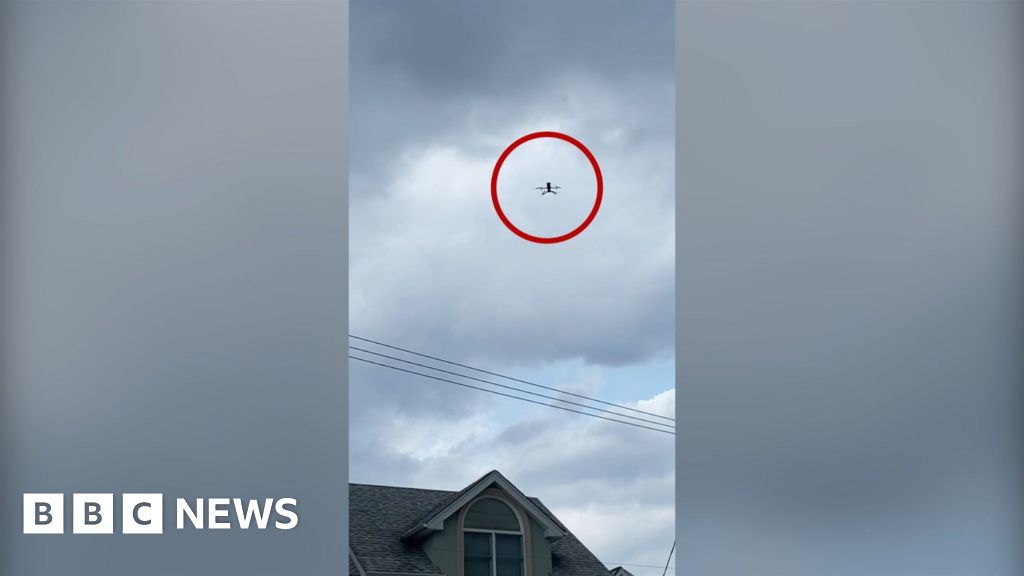
 Technology2 days ago
Technology2 days agoNYC using drones to warn residents of floods
-

 Sport7 hours ago
Sport7 hours agoUFC’s Dan Ige feels confident after Diego Lopes dominates Brian Ortega
-
Business2 days ago
Music mogul Sean Combs charged with racketeering and sex trafficking
-

 MMA7 hours ago
MMA7 hours agoConor McGregor denies allegation he sexually assaulted woman at NBA Finals
-

 News2 days ago
News2 days agoStory Behind Ryan Murphy’s FX Show About Aaron Hernandez
-

 Science & Environment10 hours ago
Science & Environment10 hours agoThe physicist searching for quantum gravity in gravitational rainbows
-

 Technology1 day ago
Technology1 day agoTech Life: The tech that refuses to die
-

 Football6 hours ago
Football6 hours agoFootball Daily










You must be logged in to post a comment Login